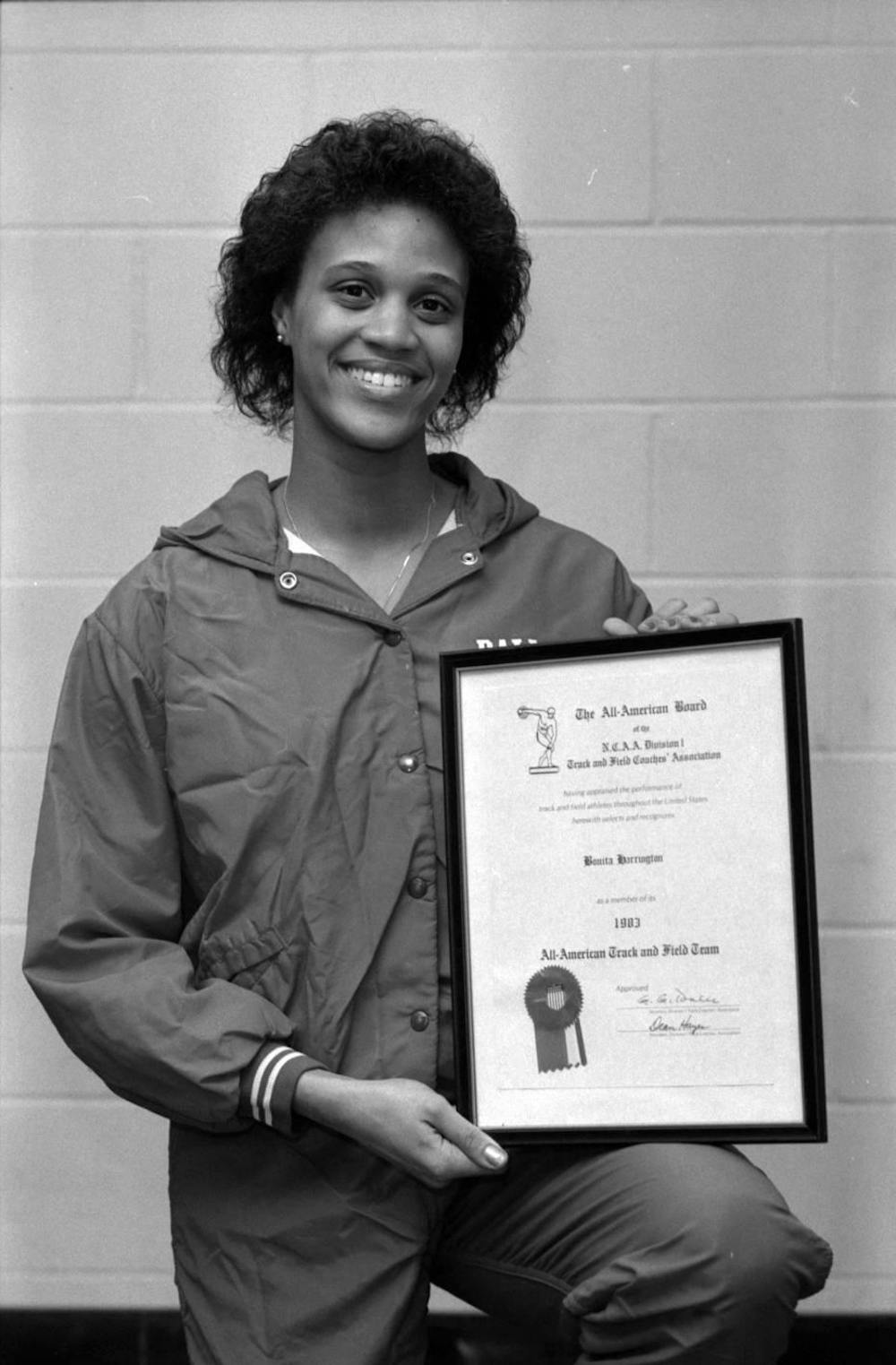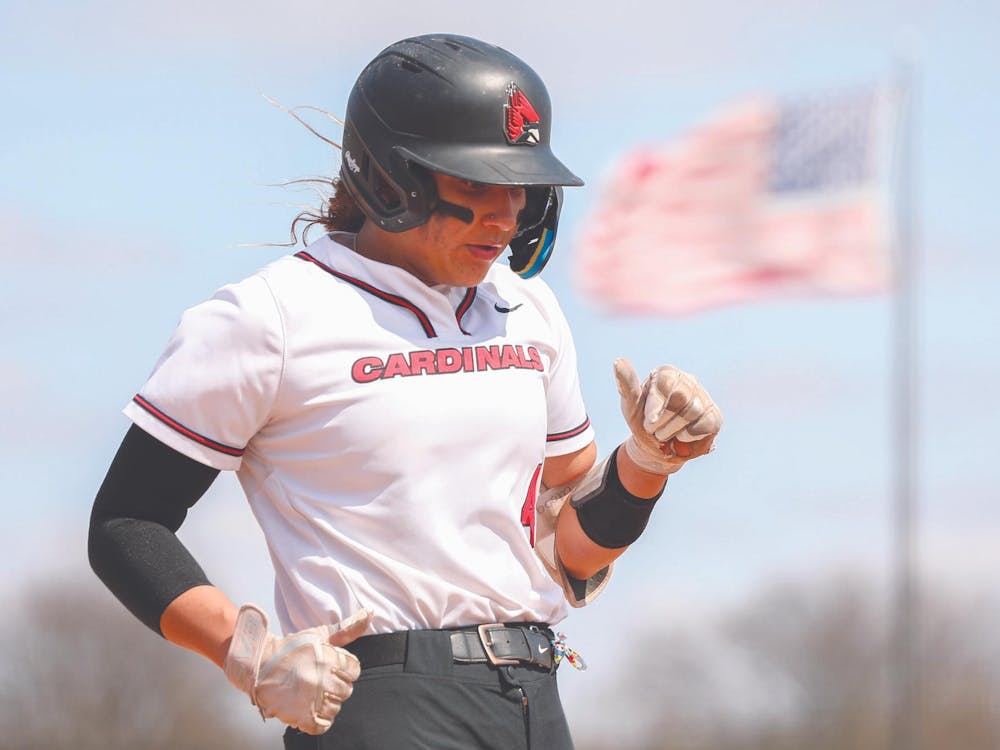The first Ball State Athletics Hall of Fame class was inducted in 1976. It was 20 years later that women were in an induction class. The women of this class consisted of Brooke Gabris, Jean Arrasmith, Emma Jones, Eileen Keener, Bonita Neal, Bernie Coffman and Beth Sova.
All of these women had incredible achievements. From being named Ball State’s female athlete of the decade by the Mid-American Conference (MAC) to being Ball State’s first female MAC individual champion to receiving a silver medal at the 1983 Olympic Festival.
Bernie Coffman
Bernie Coffman started playing softball at the age of 10. She engaged in a lot of sports and activities throughout her childhood, including gymnastics, basketball, volleyball, tap dancing and ballet.
“Growing up, I played every sport,” Coffman said. “Senior year I just focused on volleyball and softball. I focused on pitching, hoping I could get a scholarship because my parents couldn't afford to pay for college.”
Coffman’s hard work paid off when she was offered a scholarship to play for Ball State.
In her freshman year, Coffman started out playing third base, and halfway through the season, she was put in as a pitcher.
“I pitched in some games. I wasn't their starting pitcher, but the goal, for me personally, was to become the starting pitcher that year,” Coffman said. “So by the end of [my freshman] year, I was throwing more games, and then the next year I was the starting pitcher.”
At the end of her freshman year, Coffman received the Most Valuable Player award from Ball State.
After college, Coffman started working in hospitals analyzing data for them.
Coffman co-founded her own data analytics company, Sixth Sense, which does analytics for smaller hospitals across the country.
Coffman said she is able to do work remotely, which benefits her because she’s able to watch her children’s baseball games and tennis matches.
Coffman is still active in the sports community.
“[Right after college,] I ran my own pitching business for 10 years,” Coffman said. “Now I'm doing pickleball,and I walk three to five miles a day…I try to stay very active. I liked volleyball a lot, so I played volleyball leagues. I don't do that anymore… I don't want to injure myself. I ran a marathon, so it's been a lot of running… I did triathlons for a while.”
Brooke (Bauer) Gabris
Brooke Gabris focused on both gymnastics and diving when she was in high school.
Gabris also said she participated in slow-pitch softball, rollerblading and skateboarding.
“I didn't do winter sports because I was always in a competitive season,” Gabris said.“When I got to high school I decided the seasons didn't overlap, so I could do both.”
Gabris said although she was very busy attending classes, studying, going to practices and competing at meets, her diving coach, Laura Siebold-Caudill, worked around Gabris’ schedule to provide her with some extra support.
Gabris emphasized that Siebold-Caudill greatly impacted her while she competed at Ball State. She said her most memorable interaction with Siebold-Caudill was before her last dive in a meet at Northern Illinois. She said the stakes were high, and she had the potential to take the lead with a great dive.

A collage of Brooke Gabris diving into the water in 1984. Ball State Repository, Photo Provided
“I just remember having a conversation on the deck with Laura. What it was all about, I have no idea, but her enthusiasm just radiates,” Gabris said. “I really appreciate that she spent so much time with me, but her enthusiasm radiated confidence and her willingness to do the extra practices with me.”
Gabris went on to coach a year at Illinois State University for its women’s diving team. Then, she coached men’s and women’s diving at Kenyon College before coaching and teaching at Hinsdale South High School for a year.
Then, for the next 15 years or so, Gabris taught and coached diving for Libertyville High School. She then moved on to coach diving and teach at Vernon Hills High School.
Bonita (Harrington) Neal
Bonita Neal began practicing her high jump in her physical education class in elementary school.
“[In elementary school,] we didn't have a high jump pit,” Neal said. “We had Styrofoam in these big nets and sand. Not the pit like you normally see in the track; it was kind of dangerous when you think about that.”
Once she got to high school, she continued to compete in the high jump, but she also competed in some relays for track as well as volleyball and basketball.
“We're talking 40-some years ago… [and women’s sports] weren’t as prominent,” Neal said. “My older brother used to laugh at me; laugh at the way I would jump into the pit and all of that. And I was like, ‘OK, that's fine. I'll show you one day.’”
Neal was offered an athletic scholarship to Ball State after being the reigning city champion in the high jump for her entire high school career.
Neal said her first two years competing at Ball State were average. She gave herself her junior year to do the best she could in order to see if she wanted to stick with the high jump.
Her junior year, 1983, was the year she placed fourth in the NCAA championship and her first year as an All-American.
Neal also competed in the 1983 Olympic Festival at the U.S. Air Force Academy in Colorado Springs, Colorado. She went on to receive a silver medal for her performance there.
“It was a surreal experience,” Neal said.

Bonita Neal speaking at the Hall of Fame ceremony on April 14,1996. Bonita Neal, Photo Provided
She also recorded a personal record of 6-feet-1 and ¼ inches, but, at the time of this achievement, Neal wasn’t representing Ball State. The highest recorded jump for Neal in Ball State history was 6-foot ½ inch in 1984.
Neal majored in Special Education at Ball State. She student-taught at a local school while at Ball State and, following her graduation, went back to work for the school until the students she had taught graduated.
Neal then worked at Purdue University for four years as a youth educator who worked with urban programming and 4-H.
After her fourth year, she got her counseling license and took a job as a counselor in her current Indianapolis school district. She worked there for more than 30 years and retired in the spring of 2022, but she still works part-time at Lawrence Central and Lawrence North High School.
1996 HoF
Coffman, Gabris, and Neal all emphasized that it was an honor to be inducted into Ball State’s Hall of Fame.
“Because you've moved on a little bit and your life has changed, you’re no longer competing,” Neal said. “So it's cool to have been [one of the] first [women to be inducted], it was exciting. Just that they even thought about and picked me, that was cool. I was honored and humbled by it.”
Coffman spoke about how when she was playing softball at Ball State, her team didn’t have a scoreboard on their field. So, one of her professors donated an electronic scoreboard for the softball team.
“That was probably the most equitable thing that I remember. It was a really neat experience,” Coffman said.
Gabris emphasized how much she has seen women’s sports progress throughout her life; from playing to coaching.
“In my early days, getting into high school, [women’s sports] did not have the established leagues,” Gabris said. “The guys always had their conferences, we didn't have all that, we didn't necessarily have all the sports. We didn't have all the teachings. So then fast forward, I became a physical education teacher and health teacher and a diving coach at high school level [for] 35 years, and I watched how the equity came through.”
Contact Lauren Graham via email lauren.graham@bsu.edu.





